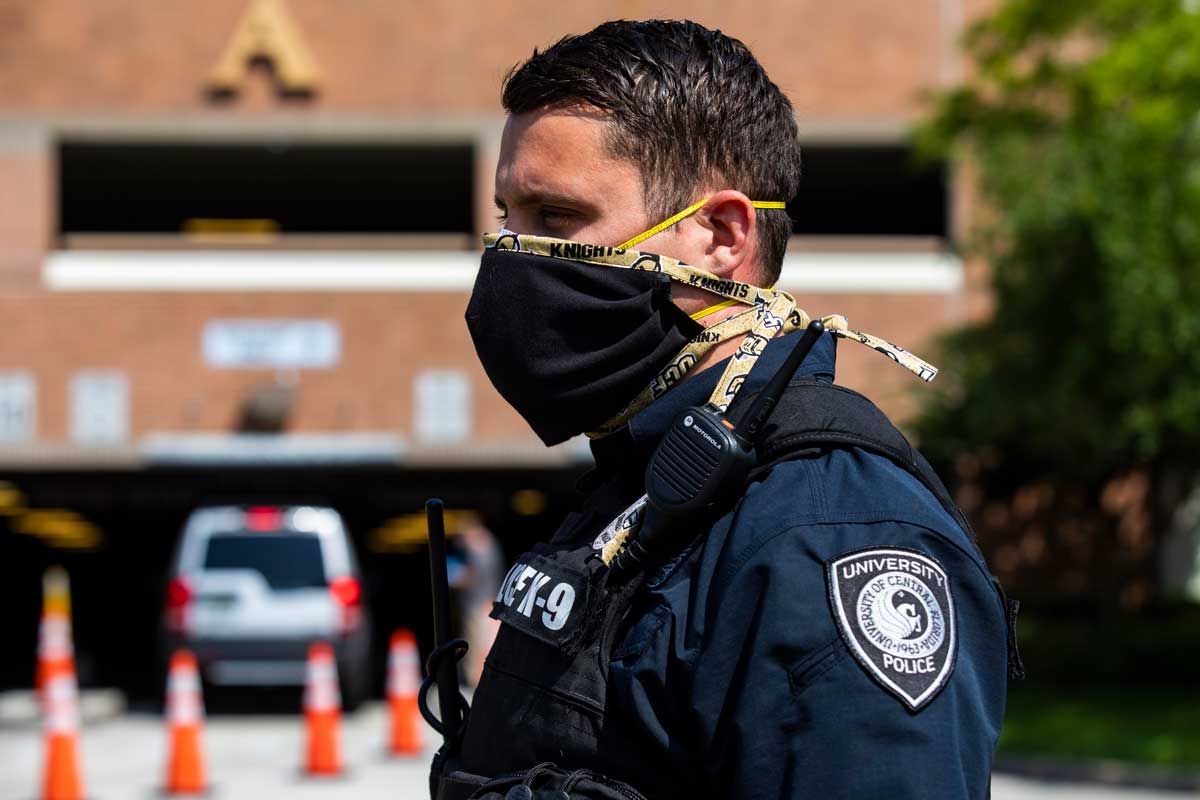As UCF Police Chief Carl Metzger ’03MS prepared for the opening of the COVID-19 testing site on campus Monday, his biggest concern was the safety of his officers working the site. So he turned to his neighbor, Professor Kristina Tollefson, for a favor.
Tollefson is the resident costume designer for Theatre UCF and knows her way around a sewing machine. He asked her if she would be willing to make 80 face masks.
Without hesitation, Tollefson said yes and enlisted the help of her five daughters to help her finish the job faster.
“I wanted to help my community in any way I could. This is what theatre people do — we figure it out and make it work no matter the circumstances,” she says.
Tollefson has been teaching at UCF since 2000. Metzger and his wife, Linda, moved into her neighborhood five years ago, and they struck up an immediate friendship.
Metzger considers the Tollefsons part of the family. Tollefson’s daughters — ages 17, 15, 14, 13 and 9 — often visit the Metzgers to play with their terrier mix, Sadie, so they were eager to join in the project and help their friend.
“[Kristina] and her husband, Jason, are the most giving and caring people I know.” — UCFPD Chief Carl Metzger
“It isn’t surprising that Kristina and her family are doing this. She and her husband, Jason, are the most giving and caring people I know,” Metzger says.
Homemade and High Quality
Tollefson has a small costume-shop studio at her house where she often spends time with her daughters doing crafts, weaving and sewing. Since they began the project Saturday, they spend most of their days in the studio cranking out masks on three sewing machines and a serger, which trims and locks seams.
Tollefson says most of the materials used for the masks have been from her personal stash with the exception of a few yards of fabric from UCF’s costume shop. She has been using grosgrain ribbon as ties, but as her stock started to deplete, Metzger’s wife purchased and delivered some UCF-themed fabric, which she left on the doorstep, to replenish and keep operations moving.
For the mask design itself, Tollefson is using a guide she found on the DIY website Instructables. The AB Mask 2.0 was created by Jessica Nandino, a former trauma nurse. All the masks are black and gold — with scrap cotton fabric of various colors used as lining — and are made with a heavyweight cotton jersey knit.
“The outside all looks very official,” she says, “because I’m a costume designer, so I was concerned that they had to go with the uniform.”
She can’t say for certain how long it takes for them to complete one mask because they’re also juggling the kids’ school work in between sewing sessions. Tollefson, who is currently on sabbatical while writing a book, says they have set up an assembly-line and each daughter has her own specialty.
They delivered 24 masks already and have another pile of 30 that are nearly finished.
“Our officers love the masks,” Metzger says. “They are more comfortable than most masks because of the tie-strings. They also have a built-in pocket to add in filtering material when it becomes available. And they are wicked cool with UCF colors and UCFPD embroidered on them.”
“If you look throughout the world, there are a lot of artists that are stepping in and using their skills right now to try to help in whatever way they can.” — Professor Kristina Tollefson
While Metzger has requested 80 masks, Tollefson plans to keep sewing as long as masks are needed. Her desire to make an impact in the community is inspired by her late friend, Harriett Lake, who was a devoted philanthropist to Orlando’s arts scene.
“The arts sometimes are looked at as superfluous to society, but in a crisis, we step in and help heal and support the people who need it,” says Tollefson, who also helped craft and organize volunteers to stitch the Angel Action Wings following the Pulse tragedy, which blocked protests at victims’ funerals. “If you look throughout the world, there are a lot of artists that are stepping in and using their skills right now to try to help in whatever way they can, in practical ways — not just in making people feel good or making them think, but using our skills to help people.”





